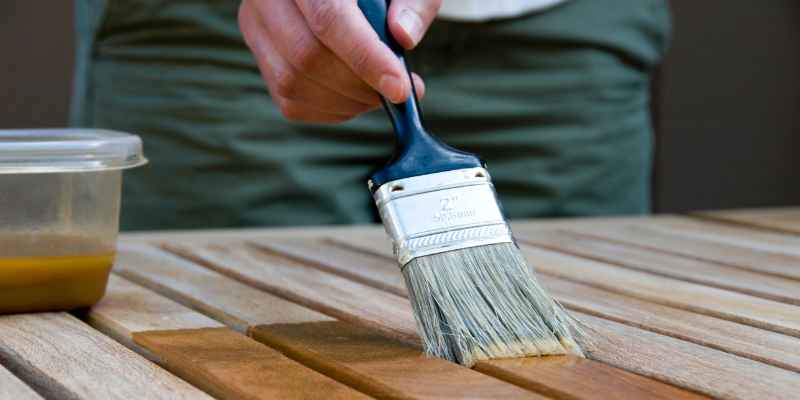Apply the second coat of stain after the first has dried completely, typically within 24 hours. Always check the manufacturer’s guidelines for specific drying times.
Staining wood enhances its natural beauty while providing protection. A well-executed staining job requires patience and attention to detail. After applying the first coat, it’s crucial to allow adequate drying time. This ensures proper adhesion of the second coat and prevents issues like streaking or uneven coloring.
Understanding when to apply the second coat can significantly impact the overall appearance and durability of the finish. Following best practices will help you achieve a flawless look that lasts. By investing time into this process, you create a stunning, long-lasting result that showcases your craftsmanship.
Introduction To Wood Staining
Wood staining is important for both beauty and protection. Timing plays a big role in getting the best results. Stains soak into the wood, enhancing its natural grain. A second coat often improves color and durability.
Wait for the first coat to dry completely. This usually takes a few hours but check the label. Humidity and temperature can affect drying time. Applying a second coat too soon can lead to streaks.
After the first coat dries, look at the color. If it seems too light, a second coat may help. Always follow the manufacturer’s instructions for the best results. Proper timing ensures your wood looks great and lasts longer.

Factors Affecting Stain Drying Times
The type of stain plays a big role in drying times. Oil-based stains usually take longer to dry than water-based stains. Generally, oil-based stains can take up to 24 hours. Water-based stains may dry in a few hours.
Environmental conditions are also very important. Humidity and temperature affect how quickly a stain dries. High humidity can slow down drying times. Warm temperatures usually help stains dry faster. Always check the weather before starting your project.
First Coat Application: Best Practices
Preparing the wood is vital for a successful stain application. Start by cleaning the surface well. Remove dirt and dust to ensure a smooth finish. Use a fine-grit sandpaper to lightly sand the wood. This step helps the stain adhere better.
After sanding, wipe the wood with a damp cloth. This action removes any leftover dust. Let the wood dry completely before applying the first coat. A dry surface ensures the stain absorbs properly.
Apply the first coat evenly with a brush or cloth. Work in the direction of the wood grain. Allow the first coat to dry fully before applying the second coat. Drying time can vary based on humidity and temperature.
Signs Your First Coat Is Ready
Check for visual cues to see if the first coat is ready. Look for an even color across the surface. If it looks saturated and slightly glossy, it might be time for another coat. Wait until it feels dry to the touch.
Use tactile tests to ensure readiness. Lightly run your hand over the surface. If it feels smooth and dry, you can apply the second coat. If it feels sticky or tacky, wait longer.
Ideal Conditions For Second Coat Application
For the best results, apply the second coat of stain under ideal conditions. Temperature plays a key role. Aim for a range of 50°F to 90°F. Keep an eye on humidity levels too. 30% to 50% humidity is perfect for staining.
Indoor projects often have different conditions than outdoor ones. Indoors, temperature and humidity can be controlled easily. For outdoor projects, check the weather forecast. Avoid applying stain during rain or extreme heat.
Here’s a quick reference:
| Condition | Ideal Range |
|---|---|
| Temperature | 50°F to 90°F |
| Humidity | 30% to 50% |
Applying The Second Coat Of Stain
Applying a second coat of stain is crucial for a rich finish. Wait at least 24 hours after the first coat. Ensure the first coat is completely dry before proceeding.
Use a high-quality brush for even application. Start from one side and move to the other. Keep a wet edge to avoid lap marks. Work in small sections for better control.
Some common mistakes include applying too thick a coat. This can lead to drips and uneven color. Avoid staining in direct sunlight, as it causes the stain to dry too quickly.
Always test the stain on a small area first. This helps in choosing the right shade and technique. Follow these tips for a professional-looking result.
Post-application: What To Do Next
After applying the first coat of stain, allow it to dry completely. This usually takes about 24 hours. Check the manufacturer’s instructions for specific drying times.
Before using the stained item, ensure it feels dry to the touch. Wait another 24 hours for best results. This extra time helps the stain cure properly.
To protect your finished project, avoid placing heavy items on it for a few days. Keep it away from moisture and direct sunlight to prevent damage.
Regularly check the finish. If you notice any wear, apply a touch-up stain to maintain its look.
Troubleshooting Common Issues
Stain not drying can happen for several reasons. High humidity makes drying slow. Cold temperatures also delay the drying process. Always check the weather before applying stain.
For an uneven finish, inspect the surface before staining. Clean and sand the surface well. Apply the stain evenly using a brush or cloth. Avoid over-applying stain to prevent blotches.
If issues persist, wait longer before applying a second coat. This allows the first coat to cure properly.

Frequently Asked Questions
When Should I Apply A Second Coat Of Stain?
Applying a second coat of stain is typically recommended after the first coat has completely dried. This usually takes about 24 hours, depending on the product and environmental conditions. Ensure the first coat is fully absorbed and not tacky to the touch before proceeding.
How Long Should I Wait Between Stain Coats?
You should wait at least 24 hours between stain coats. However, drying times can vary based on humidity and temperature. Always check the manufacturer’s instructions for specific guidance on drying times to achieve the best results.
Can I Stain When It’s Humid?
Staining in humid conditions can affect drying times and absorption. It’s best to avoid high humidity levels, ideally below 70%. If you must stain, ensure proper ventilation and consider using products designed for humid environments.
What If The First Coat Is Uneven?
If the first coat of stain is uneven, allow it to dry completely before applying a second coat. Sand the uneven areas lightly to create a smooth surface. This will help the second coat adhere better and provide a more uniform finish.
Conclusion
Applying a second coat of stain at the right time ensures optimal results. Wait until the first coat is completely dry. This enhances color depth and durability. Always follow manufacturer guidelines for best practices. A well-stained surface not only looks great but also protects your investment.
Enjoy your beautifully finished project!

